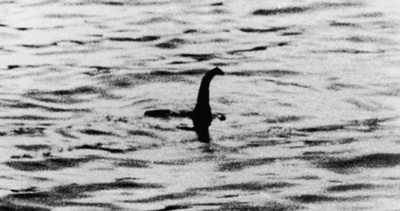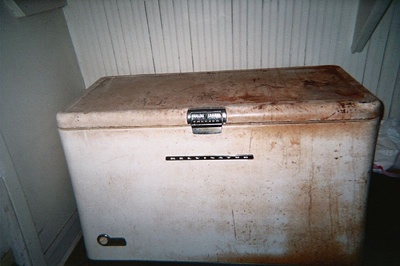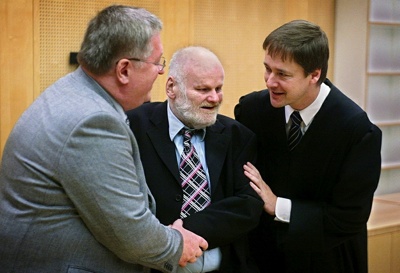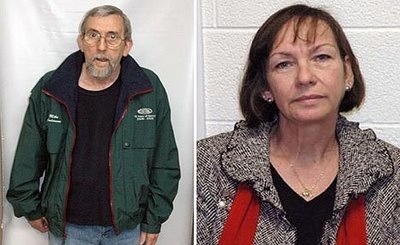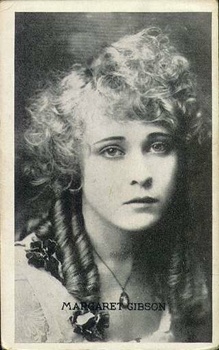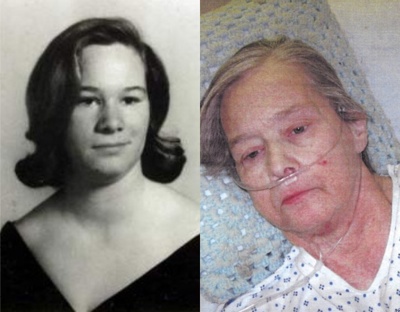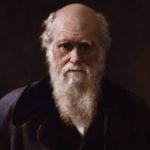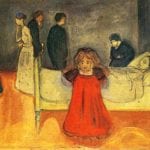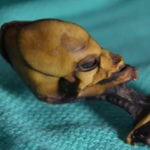 Creepy
Creepy  Creepy
Creepy  Space
Space 10 of the Weirdest Ways the Universe Works
 Weird Stuff
Weird Stuff 10 Crazy News Stories No One Expected to Read in 2025
 Crime
Crime 10 Bizarre Cases of Killer Seniors
 Technology
Technology 10 Signs That “Made in the U.S.A.” Still Lives
 Music
Music Top 10 Songs That Tell Stories Better Than Books
 Humans
Humans 10 Ways News Media Manipulate Readers
 Weird Stuff
Weird Stuff 10 Crazy-Specific Rules Dallas Cowboys Cheerleaders Must Follow
 Pop Culture
Pop Culture 10 Reasons We’ll Always Need Superman
 Our World
Our World 10 Ancient Places That Dropped Surprising New Finds
 Creepy
Creepy 10 Representations of Death from Myth, Legend, and Folktale
 Space
Space 10 of the Weirdest Ways the Universe Works
 Weird Stuff
Weird Stuff 10 Crazy News Stories No One Expected to Read in 2025
Who's Behind Listverse?

Jamie Frater
Head Editor
Jamie founded Listverse due to an insatiable desire to share fascinating, obscure, and bizarre facts. He has been a guest speaker on numerous national radio and television stations and is a five time published author.
More About Us Crime
Crime 10 Bizarre Cases of Killer Seniors
 Technology
Technology 10 Signs That “Made in the U.S.A.” Still Lives
 Music
Music Top 10 Songs That Tell Stories Better Than Books
 Humans
Humans 10 Ways News Media Manipulate Readers
 Weird Stuff
Weird Stuff 10 Crazy-Specific Rules Dallas Cowboys Cheerleaders Must Follow
 Pop Culture
Pop Culture 10 Reasons We’ll Always Need Superman
 Our World
Our World 10 Ancient Places That Dropped Surprising New Finds
Top 10 Fascinating Deathbed Confessions
When death is inevitable some people decide it is a good time to confess to things that have burdened them during their lifetime. Perhaps it is in order to leave the world with a clear conscience or maybe to benefit the living ones they leave behind. This list contains 10 deathbed confessions and the stories behind them of people who, for whatever reason, decided to reveal their darkest secrets.
Confessed to: using a Basque lullaby melody for her song Jerusalem of Gold
Naomi Shemer is one of Israel’s best loved songwriters. The song Jerusalem of Gold was first performed in 1967 at an Israeli song festival shortly before the Arab-Israeli war and describes the Jewish people’s 2000-year longing to return to Jerusalem. It continues to serve as an unofficial Israeli anthem and is often played at national ceremonies. Shemer spent many years denying claims that she plagiarized a lullaby song and turned it into Jerusalem of Gold. Then in 2004 after years of angry denials she made her confession to another composer Gil Aldema just days before dying of cancer writing to him, “I consider the entire affair a regrettable work accident – so regrettable that it may be the reason for me taking ill,” she also wrote that she heard a well-known Basque lullaby which “went in one ear and out the other” and the song must have crept into her unwittingly. Aldema said that Shemer had agreed for her secret to be revealed after her death.
Interesting Fact: In 2005 the lullaby Pello Joxepe became known worldwide when it was published that Jerusalem of Gold was based on its melody. The Spanish singer Paco Ibáñez who performed the song in Israel in 1962 where Shemer first heard it was asked how he felt when he heard Naomi Shemer based most of the melody on the lullaby. He replied by saying he was honored that she chose to use his melody to use for Jerusalem of Gold. You can listen to the song here performed by Ofra Haza at an Israel concert in 1998.
Confessed to: the legendary clock collection heist
In 1983, the costliest theft in Israel’s history saw 106 timepieces worth millions of dollars disappear from a Jerusalem museum. Included in the timepieces was a pocket watch made for Marie Antoinette which is valued at more than £19m ($30 million). The case remained unsolved for almost 25 years until 2006 when a Tel Aviv watchmaker told police that he had paid some $40,000 to an anonymous person to buy 40 items including Marie Antoinette’s pocket watch (pictured above). Forensic experts examined the clocks and detectives questioned the lawyer who negotiated the sale. The trail led to an Israeli woman in Los Angeles named Nili Shamrat who police identified as the widow of Naaman Diller who was a notorious criminal in the 1960s and 1970s. When Israeli police and US officials arrived at her home to question her they found more stolen clocks. Shamrat then told the police that her husband who she had recently married confessed to her just before he died that he had committed the heist. He then advised his wife to try and sell his collection after his death.
Interesting Fact: The Marie Antoinette watch was actually self winding and was ordered in 1783 by one of her admirers and was to be made by the famous Swiss watchmakers Abraham Louis Breguet. The order specified that gold should be used wherever possible instead of other metals and to make it the most spectacular watch possible. The watch was finally finished in 1827, 34 years after Marie-Antoinette was guillotined and four years after Breguet’s death.
Confessed to: faking the famous Loch Ness Monster photo
In 1934 a doctor named Robert Kenneth Wilson offered a picture to the Daily Mail newspaper. Wilson told the newspaper he noticed something moving in Loch Ness and stopped his car to take the photo. Wilson refused to have his name associated with it so the photo became known simply as “The Surgeon’s Photo.” For decades this photo was considered to be the best evidence of the existence of the Loch Ness Monster. In 1994 at the age of 93 and near death Christian Spurling confessed that the surgeon’s photo taken 60 years ago was a hoax and the mastermind behind it was his Stepfather Marmaduke Wetherell.
In the early 1930s, sightings of the Loch Ness Monster became commonplace, so Spurling’s stepfather who was a big game hunter was hired by the Daily Mail newspaper to investigate. Wetherell found some huge tracks leading to the lake that he proudly displayed to the press. When the Natural History Museum investigated they quickly discovered that the footprints were a hoax. Wetherell was humiliated when the newspaper reported this and for being fooled by the prank. For revenge he asked his stepson Chris Spurling who was a professional model-maker to make something that would fool the public. Spurling started with a toy submarine and then added a long neck and small head. The finished product was about 45 cm long, and about 30 cm high. Wetherell then went down to the lake and took some pictures of the “monster”. To add respectability to the hoax he convinced Dr. Wilson whom he knew through a mutual friend to develop the photo and sell it to the Daily Mail.
Interesting Fact: This deathbed confession is often mistakenly attributed to Roger Patterson of big foot fame. (The Paterson Film) Paterson died of cancer in 1972 and in this case swore on his death bed that the footage was authentic and he had encountered and filmed a large bipedal animal unknown to science.
Confessed to: the murder of her husband John Kelly
In 1991, after years of domestic violence, Geraldine Kelly shot and killed her husband and stored his body in a freezer at their home in Ventura, California. She told her young children that their father died in a car accident. Seven years later when she decided to move back home to Somerville Massachusetts she had the moving company move the freezer with the body inside and drive it across the country to a local storage facility in Somerville. In 2004, 13 years after the murder Kelly was gravely ill with breast cancer and confessed to her daughter that she had killed her father claiming he abused her for years and then told her where to find his body. Authorities investigated and found human remains in a locked, unplugged freezer in the storage room. The body was mummified but identified as John Kelly based on distinctive tattoos he was known to have including a panther, a Kewpie doll and a skull. The cause of death was a gunshot to the back of the head.
Interesting Fact: The District Attorney of Somerville said it wasn’t clear if Kelly wanted to unburden herself or if she wanted her children to know so if they found the body they wouldn’t be blamed for it.
Confessed to: the murder of Torunn Finstad and Sigrid Heggheim
In 1978, Fritz Moen (pictured center above) was 36 when he was arrested for raping and killing 20-year-old Torunn Finstad in Trondheim, Norway. There was no physical or forensic evidence linking Moen to the crime and no witnesses saw him with Finstad. Moen was deaf with a severe speech impediment and an interpreter was needed for him to communicate effectively. Moen was found guilty of the murder and sentenced to 20 years imprisonment. Several years later police claimed that Moen had confessed to the 1976 murder of 20-year-old Sigrid Heggheim. During the seven interrogations his confession came during the one time in which he did not have the benefit an interpreter. He was found guilty of this murder as well and sentenced to an additional 5 years in prison. In 1996 after spending 18 years in prison he was released and placed under preventative supervision.
During the next several years Moen’s attorneys tried desperately to clear his name. In 2004 he was acquitted for the murder of Sigrid Heggheim finding that reasonable doubt should have acquitted him in the first place. Then in December 2005 a convicted felon Tor Hepso confessed at a hospital one day before he died to three nurses and later to the police that he had murdered two women and mentioned the names Heggheim and Finstad. After Hepso’s deathbed confession was thoroughly investigated Moen was finally exonerated of the murder. Unfortunately Fritz Moen died of natural causes earlier that year in March and was not alive when he was declared completely innocent of the both crimes.
Interesting Fact: This case was publicly criticized as one of Norway’s most shameful miscarriages of justice. There is even talk of erecting a bust or statue of Moen in front of the Norwegian Ministry of Justice as a symbol of the responsibilities of the criminal justice system.
Confessed to: the murder of Willie Edwards
I think most would agree that this confession was too little too late and another example of a miscarriage of justice. In 1957 the body of a 25 year old black man Willie Edwards was washed up on the shores of the Alabama River. Although there was much suspicion surrounding his death officials stated that decomposition made it impossible to determine the cause of death. In 1976, an aggressive attorney re-opened the Edwards case and four Klansmen were arrested including Henry Alexander. One of the men gave a sworn affidavit (in exchange for immunity). In the statement the man described how he and three other men beat and forced Willie Edwards to jump off the Tyler-Goodwin Bridge because he said something offensive to a white woman. Even with one of the men’s sworn testimony, Alabama Judge Frank Embry dismissed the charges because no cause of death was ever established. He concluded that “merely forcing a person to jump from a bridge does not naturally and probably lead to the death of such person.” In 1992, Henry Alexander now 63 was near death from lung cancer and decided to confess to his wife. He told her he had things bothering him and said Willie Edwards would not have died if he had not falsely identified him as the one who had offended the white woman. He then said he and the other Klansmen gave Mr. Edwards a choice to run or jump and didn’t think he would jump. He said. “If he’d a run, they would never have shot him.”
Interesting Fact: After her husband’s confession Mrs. Alexander wrote a letter of apology to Mr. Edwards’s widow. In the letter she writes “I hope maybe one day I can meet you to tell you face to face how sorry I am. May God bless you and your family and I pray that this letter helps you somehow.”
Confessed to: Killing his Neighbor Jimmy Carroll
In 1977 James Brewer was arrested in Tennessee on suspicion of killing his neighbor in a fit of jealous rage. Brewer jumped bail and fled to Oklahoma where he and his wife began a new life together under the names Michael and Dorothy Anderson. They became active members of the local church where his wife established a Bible study group. They also have a married daughter and are grandparents. In 2009, Brewer had a serious stroke and before dying he felt compelled to confess to the crime that had weighed on his conscience for over 3 decades. His wife then called the Police Department to the hospital saying her husband wanted to confess to a murder. Brewer confessed to his crime with the help of his wife who had to translate due to the effects of the stroke. The only problem with this deathbed confession is that fortunately or unfortunately for Mr. Brewer he didn’t die. When Brewer was released from the hospital he surrendered to Tennessee authorities and appeared in court with the same lawyer he had almost 32 years earlier when he jumped bail. The picture above shows Mr. & Mrs. Brewer after their arrest.
Interesting Fact: The Pastor of the church where Mrs. Brewer set up a Bible study group, said: “I don’t know what their former life was but I do know they were both dedicated to the Lord. They’ve been in their own prison for 30 years. I think they’ve done their time.”
Confessed to: the Murder of William Desmond Taylor
William Desmond Taylor was an actor and a top US film director of silent films in the early days of Hollywood. When Taylor was shot to death in 1922 it became one of Hollywood’s most famous scandals and mysteries. In 1964, 42 years after the murder a reclusive old woman living in the Hollywood hill was suffering from a heart attack and summoned her neighbor. With her recent conversion to Catholicism she asked for a priest to confess but when no Priest was available she began to make her confession to her neighbor. As she was dying on her kitchen floor she said she was a silent film actress by the name of Margaret Gibson and that she shot and killed a man named William Desmond Taylor. She is alleged to have been involved romantically with Taylor but a motive as to why she killed him was never mentioned. Taylor’s murder remains officially unsolved however the one thing that stands out is that Gibson had absolutely nothing to gain by her confession. Another revealing fact that should be mentioned is the neighbor that witnessed Gibson’s confession said his mother (who was a friend of Gibson’s) later said that when they were watching a TV piece on the Taylor murder she became hysterical and blurted out that she’d killed him.
Interesting Fact: In the 1950 film Sunset Boulevard, the name Norma Desmond is a reference to both Taylor’s middle name and one of his actress friends Mabel Normand.
You can watch a silent movie called “The Kiss” Starring William Desmond Taylor and Margaret Gibson here.
Confessed to: the murders of Constance Smootz Hevener and Carolyn Hevener Perry
In 1967, 20-year-old Carolyn Hevener Perry and 19-year-old Constance Smootz Hevener were shot to death while working at an ice cream store in Staunton Virginia. Each had been shot once in the head at closing time and about $138 was stolen from the store. Over the years police worked the case but with no luck. Then in November 2008, police were led to Diane Crawford by new information revealed by a witness. When police went to question Crawford she was at the end-stages of heart failure and suffered from chronic kidney disease and decided to confess in detail to the murders that she committed over 40 years ago. On the night of the shooting, Crawford who was 19 at the time said she went to the store where she worked part time to tell the women she could not work the next day and ended up in a shoving match with them. Crawford then took out a .25 caliber pistol and shot the two women because they had made fun of her for being a lesbian. Perry was the first to be shot at near-point-blank range and when Hevener rushed to her aid Crawford shot her also from just a couple of inches away. She then took money from the store as she fled which led the police to think it was a robbery. Crawford died in January 2009, 2 months after confessing to the murders. The photo above shows Crawford in her 1966 high school year book picture and in her police mug shot.
Interesting Fact: Diane Crawford moved away after the killings for 20 years, got married and had two daughters. She then returned to Staunton without her husband and moved in with a woman and lived with her new partner until her death.
Confessed to: stealing a Stradivarius violin from Bronis?aw Huberman
I put this at the number one spot not because of the severity of the crime but for the overall story surrounding this deathbed confession. In 1936 Polish virtuoso Hall Huberman was performing at Carnegie Hall and decided to switch the Stradivarius he was playing in the first half of his performance to his newly acquired Guarnerius violin. After the intermission the Stradivarius was stolen out of his dressing room by 20 year old Julian Altman who was a New York nightclub musician. Altman went on to become a violinist with the National Symphony Orchestra in Washington, D.C. and performed for Presidents and politicians with the stolen Stradivarius for many years. In 1985, 49 years after the theft, Julian Altman who was in prison for child molestation and gravely ill confessed to his wife that he had stolen the violin. He then instructed his wife where to find the Stradivarius at the couple’s home. Along with the Stradivarius she found newspaper clippings recounting the theft. It wasn’t until 1987 (2 years later) that his wife returned the Stradivarius to Lloyds of London in exchange for a $263,000 finder’s fee.
Interesting Fact: This violin is now called the Gibson ex-Huberman Stradivarius named after its two previous owners; George Alfred Gibson and Hall Huberman (No love for Altman I guess). It is now owned by violinist Joshua Bell who is pictured above playing the famous violin which he paid close to 4 million dollars for.


